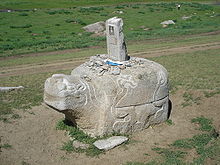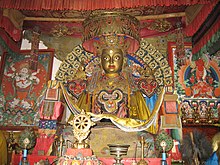Sculpture of Mongolia
Works of
The spread of Buddhism in Mongolia from the 16th century was associated with a cultural revival which included the work of the sculptor Zanabazar (1635–1723), famous for his human forms in bronze depicting figures from the Buddhist tradition. Also known from this period are the ornate masks used in the mystic Cham dances.
A sharp change in Mongolian art followed the revolution of 1921, after which the country remained under strong Soviet influence. Buddhism lost its hold, and much sculpture in public places adopted the Socialist realist style. Later Western influences introduced Modernism to sculpture, and since the overthrow of the socialist regime in 1990, abstract and traditional styles have been explored.
Bronze age sculpture
Most scholars estimate that Bronze Age nomads erected the graceful and mysterious megaliths throughout the northern regions of Mongolia and southern Siberia around 1000 BCE, though some scholars think they may be the work of later, Iron Age peoples who appeared by 700 BCE in Mongolia.[2] There are pictures of the sun and moon near the top of the deer stones below which is a line of a geometric ornament. Then there are the pictures of deer characterized as in a “flying gallop”. Below the deer depictions is another belt decorated with geometric ornaments.[3] On rare specimens, a depiction of a human face is found. In the upper part of a deer stone discovered at a site named Shar-Us, there is a depiction of the disk of the sun on one side and a picture of a human face on the other side.[4] The Scytho-Siberian style is also characteristic of the metal works of Bronze Age craftsmen. Handles of knives were decorated with figures of the head of a deer, ram or goat with enlarged ears, protruding eyes, and spiral horns. These objects belong to the Karasuk culture which originated in Mongolia and spread northwards to Siberia and southwards to Yin China.[1]
Medieval sculpture
The
The sculptural complexes dedicated to the memory of the Turkic advisor Tonyukuk and Turkic warlord Kul Tegin were built in the 8th century. The memorial complex of Kul Tegin was surrounded by a metre-wide wall. A two-storey building supported with 12 columns was at the centre of the complex and marble statues of Kul Tegin and his spouse were located in the building. The head of the statue of Kul Tegin is topped with a crown with a depiction of a bird spreading its wings.[1]
Archeological findings demonstrate that the
Sculpture of the Mongol Empire
The development of sculpture of imperial Mongol times has to be judged by the few but highly expressive samples of stone men, stele and decorative architectural elements. The stone figures in Sükhbaatar aimag are distinguished by their headdresses, clothes, ornaments, postures and seats. Important artifacts include the Stele of Genghis Khan[10] documenting the achievement of Yesunke Mergen’s art of archery, and the obelisk dedicated to Möngke Khaan.[11][12] Such stele stood on the back of stone tortoises similar to those found around the capital of the Mongol Empire Karakorum.[1]

Archeological excavations of ancient Karakorum unearthed a wealth of heritage of the art of the period of the Mongol Empire. Palaces and temples were decorated with sculptures. The corners of the roofs were decorated with heads of winged dragons. A large number of figurines of creatures similar to phoenixes and chimeras as well as statuettes of humans in Buddhist clothing have been unearthed. One of the fragments of sculptures of women found in the ruins of Karakorum depicts a woman with big eyes, tender smile, half-open lips and hairpins in the form of flowers, and a happy expression reminiscent of the traditional Uighur school. The fragment of another statuette, even better proportioned, is that of a woman with regular Mongolian-type features.[1]

Based on the records of William of Rubruck, most scholars maintain that in front of the palace was the Silver Tree (Мөнгөн мод) fountain. According to Rubruck, there were four silver sculptures of lions at the foot of the Silver Tree, and fermented mare's milk — airag, favourite drink of the Mongols — would run from their mouths. Four golden serpents twined round the tree. Wine would pour from the mouth of one serpent, airag from the mouth of the second serpent, mead from the third, and rice beer from the fourth. The top of the tree was crowned by an angel blowing a bugle. The branches, leaves and fruits of the tree were all made of silver. The fountain was designed by a captive sculptor William of Paris.[3]
Renaissance and Buddhism
G. Zanabazar and his school

Reintroduction of Buddhism to Mongolia in the second half of the 16th century and its active penetration into all aspects of the Mongolian society directly influenced the further development and flourishing of sculpture and other arts in Mongolia.
The Renaissance of culture of Mongolia is related with
Vajradhara, the Dhyani Buddhas and other deities show the 32 main and 80 secondary features of an ideal human body. They are in harmony with the canonical proportions described in
The art of Cham
Mongolian Cham is of special interest because this type of sacred performance attained during its brief life span in Mongolia a level never equaled elsewhere. Although Tibetan and Mongolian manuals which detail the iconography and outline the choreography of the Tsam exist, eyewitness accounts of early Western travelers imply that the dances actually differed in many ways from the manuals.[16]
Cham masks of Mongolian production, for example, have an artistic expressiveness only rarely matched in other countries.
The masks are treated as sacred objects, just as Buddhist statues. When they are not in use, they were stored in monasteries and paid homage to in daily rituals.[16]
“Socialist realism”
The best known specimen of sculpture of the period of Socialist Realism are the Equestrian statue of Sukhbaatar, one of the leaders of the Revolution of 1921, statues of a shepherd and peasant in front of the building of Ministry of Agriculture and the Zaisan Memorial for the Soviet soldier.
Modernism and traditions
. In the 1960s, Mongolian artists began to study in countries such as East Germany and Czechoslovakia where they picked up Modernist art styles. These artists broadened the range of Mongolian artistic expression and adopted a greater degree of individualism. Although discouraged by the socialist government, Mongolian artists created increasingly free and emotional compositions. By the 1980s, greater numbers of artists returned from study in Europe and modernism was flourishing in Mongolia. The Democratic Revolution of 1990 opened Mongolia to the world and artists were completely free to paint any subject and travel to any country abroad. New artist groups were formed committed to modern and contemporary art in reaction to the dominance of Realism over the past decades. Previously taboo topics, such as the Mongol leader Genghis Khan, and abstract art styles were explored with passion.[17]
At the same time, a revival of traditional art styles arose. Monk-artist
.References
- ^ a b c d e f g h i j k l Tsultem, N. (1989). Mongolian: ᠮᠣᠩᠭᠣᠯ ᠣᠨ ᠣᠷᠠᠨ ᠪᠠᠷᠢᠮᠠᠯ (Mongolian Sculpture). Ulan Bator.
{{cite book}}: CS1 maint: location missing publisher (link) - ^ Powell, E. A. (2006). Mysterious Mongolia.
- ^ a b c d Chultem, N. (1984). Искусство Монголии. Moscow.
{{cite book}}: CS1 maint: location missing publisher (link) - ^ Волков, В. В. (1964). Из истории изучения памятников бронзового века Монголии. Ulan Bator.
{{cite book}}: CS1 maint: location missing publisher (link) - ^ Соловьёв, А. И. Древние тюрки.
- ^ Мелиоранский, П. М. (1898). Об орхонских и енисейских надгробных памятниках с надписями.
- ^ Евтюхова, Л. А. Каменные изваяния Южной Сибири и Монголии.
- ^ Евтюхова, Л. А. Буддизм в период правления Угэдэй-хана.
- ^ Early Mongol State.
- ISBN 9781135796907.
- ISBN 9783447040419.
- ^ "The National Museum of Mongolian History : The Mongol Empire of Chingis Khan and his successors". depts.washington.edu. Retrieved 2017-03-26.
- ISBN 0-500-23705-0.)
{{cite book}}: CS1 maint: location missing publisher (link - ^ a b Bartholomew, Terese Tse (1995). Introduction to the art of Mongolia.
- ^ Buddhist ritual: Buddhist monastic dance.
- ^ a b c Ceremonial Masks of Mongolia.
- ^ a b Mongolian National Modern Art Gallery.
